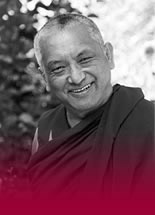Travel Blogs
20 November, 2016 | Nepal
Wednesday, November 16: we’re back in Kathmandu, having just finished my twelfth three-week pilgrimage to Nepal and India, which raises funds for Liberation Prison Project. Well, actually, the first was in 2001, so it’s the sixteenth, but it’s my twelfth.

And I’m not bored yet! I love doing these journeys to the holy places in India where Lord Buddha walked and taught and meditated. I always say it, and I’ll say it again this time: the participants love it as well. Everyone is so moved. Every year, it seems, people say it’s changed their lives; that they had special dreams, special meditations. And everyone seems to get along really, really well. I remember during one of our first pilgrimages, one guide we used in Varanasi said she was surprised at how harmonious the group was; that most groups she led fairly quickly developed into cliques. She decided that the harmony in our group must be due to the fact that the motivation was spiritual.
I think she’s right. Not that we walk around being holy all the time: everyone utterly enjoys themselves, has fun, shops, and eats. And there’s lots of laughter. Already we’re planning 2017’s.

Above: Actually, this is not His Holiness teaching – it’s a propped-up photo on the throne at Kopan; Below right: One of the Tibetan volunteers working on the repair of Boudhanath Stupa was delighted to meet a group of Westerners praying and making offerings, below left. Photos Catherine de Long & Marguerite Sharkey.
 |
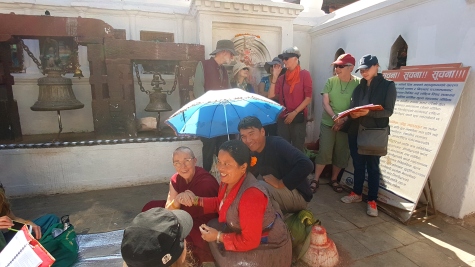 |
As always, we start in Kathmandu. After 20–30 hours of flying, when everyone ends up at the luxurious Hyatt, they’re always shocked and delighted! Just naturally the expectation is of a third-world hotel. No. It’s far from that! And I chose that purposely. Make people happy and relaxed and comfortable, that’s what I figured. Then we’re all ready to go on our wild bus ride through India.
First, though, we have our four-day retreat at Kopan Monastery. That’s always a winner, too. People love Kopan!
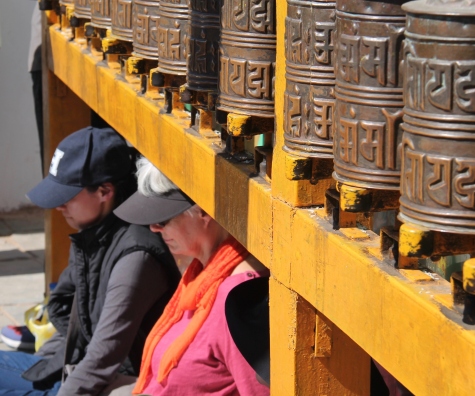
Boudhanath is Little Tibet these days. While circumambulating, below, we follow Rinpoche’s instructions to offer jewels – rice visualized as such – to the guru manifesting as the stupa. Photos: Catherine & Marguerite.
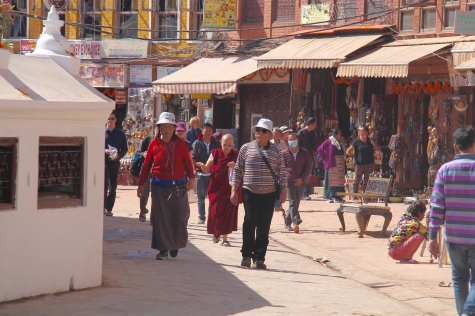
After the four days at Kopan we spent the next two visiting the holy sites in and around Kathmandu. November 2 we went to Boudhanath Stupa, that ancient place loved by Tibetans, where they gathered after coming into exile in 1959. It’s virtually Little Tibet these days. As I mentioned in Postcard 74, the stupa was damaged in the recent earthquake and was still being repaired when we first visited. We weren’t allowed on the top of the stupa, which is typical, so did our prayers and practices just inside the entrance. In the afternoon it was Swayambunath, on the other side of town, another powerful stupa.
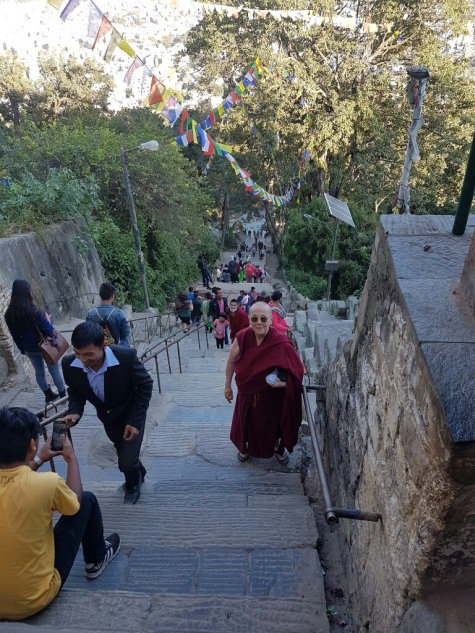
Above and below: Swayambhunath Stupa takes effort to get to: about 200 steep, steep steps! Photos: Catherine de Long & Marguerite Sharkey.
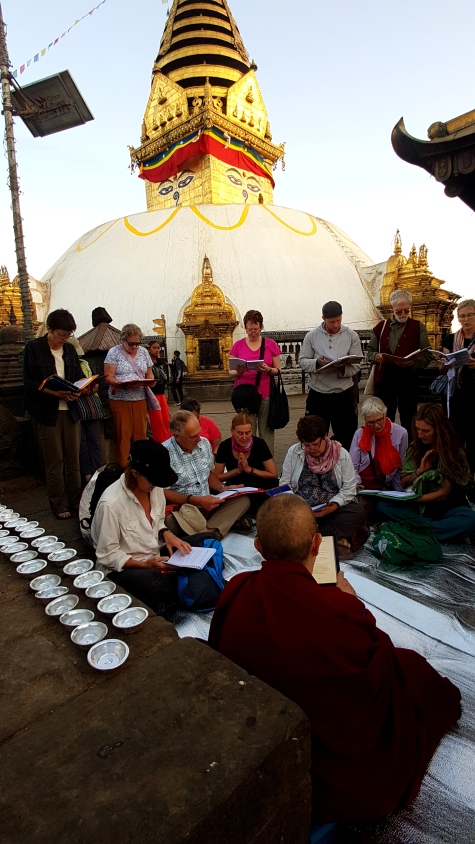

Discussing our next move with Amber at Swayambhu Stupa – not for nothing is it known as the Monkey Temple. Let’s hope the little guy below is a buddha manifesting as a monkey, otherwise it’s a monkey stealing offerings to the buddhas. . . Photos: Catherine de Long & Marguerite Sharkey

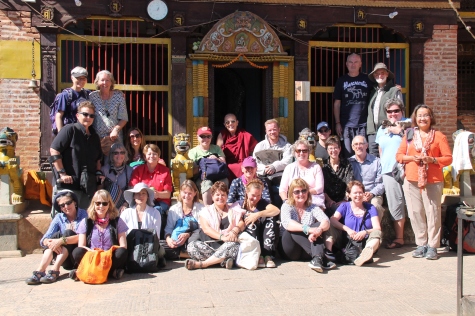
Above: After our offering of tsog to Vajra Yogini, upstairs in the little temple at Pharping. Photo: Marguerite Sharkey. Below: Amber leading the way to lunch.

The next day, November 3, we drove two hours southwest of Kathmandu to Pharping, a place renowned for the presence of meditators, not just now but for the past thousand years. There are caves there where Padmasambhava, or Guru Rinpoche, meditated and a little wooden temple famous for the Vajra Yogini practitioners, disciples of Naropa, the Pamptingka brothers. There’s an astonishing statue of Vajra Yogini in the tiny room upstairs, locked inside a little cave-like place. You can hardly see her as she’s covered in layers of clothing.
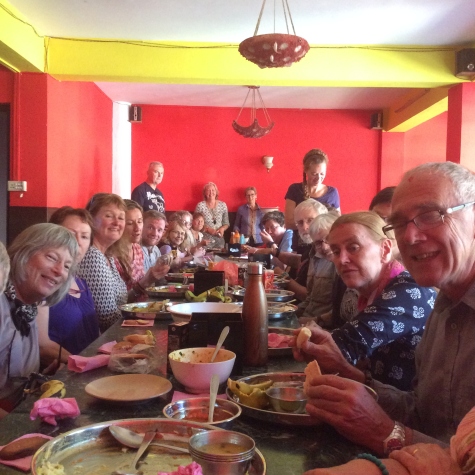
Traditional Nepalese lunch at a Tibetan café in Pharping. (I took the photo.)
November 4 we drove to the airport and flew to Lumbini, Buddha’s birth place, 30 minutes away. There we met our Indian driver and his bus, which would take us through India for the rest of the pilgrimage.
After one night in Lumbini it’s a couple of hours to the Nepal-India border, a pretty casual border, it always seems to me. First a little office for Nepal immigration, then a bit of a walk through what seems one village to another little office for India immigration. At their main airports both countries are incredibly strict in policies entries in and out – you’d practically be put into prison if you overstay either place for even a day – yet it seemed to me that this border hardly exists; I couldn’t see anything preventing anyone from walking casually from one country to the next without being noticed.
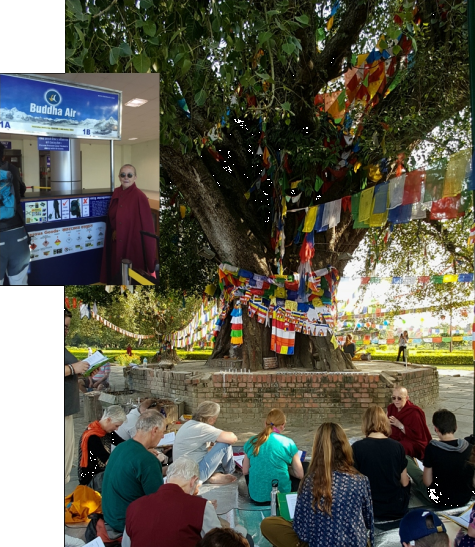
We were in good hands on our flight to Lumbini, where Buddha was born.
We all got through and drove the eight hours or so west to Sravasti. On most of our bus journeys, usually not less than eight hours, we’d stop for lunch in the villages: samosas, pakoras, and chai. People loved it! Not to mention the cost: chai and samosas: 10 cents apiece. It hasn’t changed for 20 years – and probably longer.
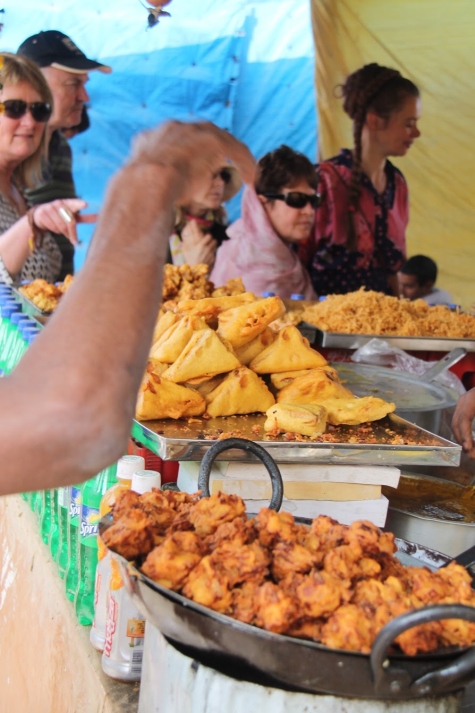

The recipe for the 10-cent samosas were unique to each place, and always more delicious, people said, than the $5-dollar versions they’d had at home. Photo: Marguerite Sharkey.

And the chai? Indian espresso, as far as I’m concerned. Photo: Marguerite
Sharkey.

Sravasti is serene and lovely: it’s where Lord Buddha and his disciples spent their rainy seasons, meditating. Below, singing our prayers. Photos: Catherine.


Every year our bus drivers are great. They’re relaxed, good drivers, don’t get upset, toot their horns only when necessary – in India, that seems to be all the time! – and drive up to 15 hours if they have to. And they’re always immaculate. They sleep in the bus, so don’t ask me how their shirts are always so neat and clean.
The company that sends us the buses is based in Varanasi. They meet us at Lumbini and we spend the final two weeks on the road with them. People seem to like the buses: we can relax, sleep, read stories, and discuss the teachings.

Giving Victoria a helping hand. Photos: Marguerite and Catherine.

Offering jewels to the guru manifesting as the stupa, this one at Kushinagar, where Lord Buddha passed away. This stupa is unadorned, simple and raw. One of my favorites. Photos: Marguerite and Catherine.


 |
Above: Varanasi and the ghats at the Ganges. Photo: Catherine.Left: And, of course, Deer Park at Sarnath, a few miles away, where Buddha gave his first teaching. Photo: Marguerite. |

With old friends at Bodhgaya: Ven. Tsenla, left, and Ven. Anet. And our usual pujas, below.
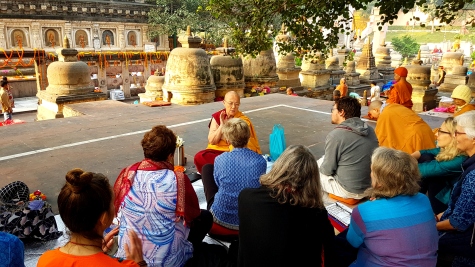
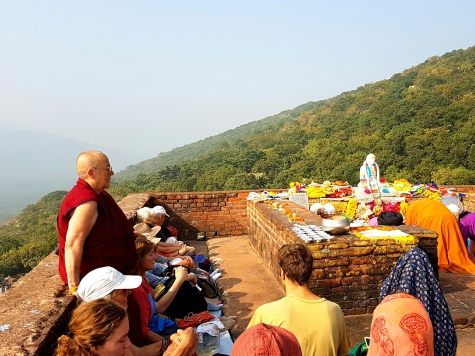
 |
Then a one-day roundtrip to Rajgir to visit Vulture Peak, where Buddha taught many times, and the ruins of Nalanda Monastery, the home of our lineage lamas – Nagarjuna, Chandrakirti, Shantideva, et al. And, finally, back to Kathmandu for our final puja at the shiny new Boudha Stupa. Then home for everyone. Photos: Marguerite. |

